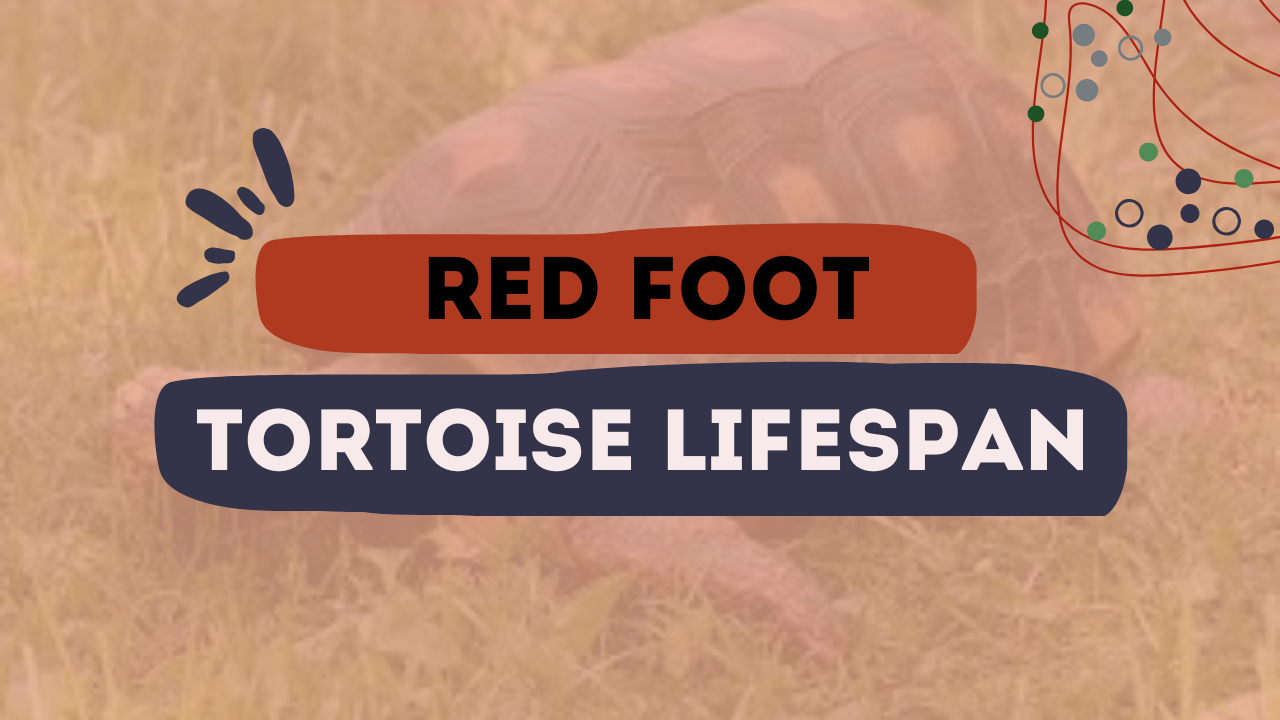You’re in for a shell-load of shocks if you’re wondering how long red foot tortoises live! When given the right care, these endearing little creatures well, maybe not so small; they can get very large have a reputation for living remarkably long lives. Let me state this from the beginning: purchasing one (or adopting one) is a serious decision. Give or take, you’re essentially committing to decades of friendship. Decades, indeed! And, of course, they have their own peculiarities, maintenance needs, and that characteristic red foot marking (thus the name). In-depth discussion of the factors influencing their longevity, tips for extending it, and some entertaining lifespan trivia will all be covered in this article.
Table of Contents
A Quick Overview
- Average lifespan in nature: 40–50 years
- Lifespan in captivity: typically 20–40 years, occasionally longer
- Keepers of documentation: Some people are said to have lived for more than 60 years.
- When it comes to longevity, these tortoises are no joke. However, like with all living things, a number of elements are involved.
What Is the Typical Red Foot Tortoise Lifespan?
For the scientifically inclined among us, red foot tortoises (Chelonoidis carbonaria) often live between 40 and 50 years in the wild, and maybe more if they stay clear of diseases and predators. Depending on how well they are cared for, they may live somewhat shorter or roughly the same amount of time in captivity. According to some loyal owners, their red footers have lived for 60 years or more, which is absurd to consider (that’s longer than some marriages I’ve witnessed!).
It’s not a given, though. The lifespan of a red foot tortoise can be shortened in the absence of adequate nutrition, veterinary care, temperature regulation, and enrichment. Do you believe that veterinarians are only for dogs and cats? Consider your thought.
Key Factors That Affect Their Lifespan
1. Nutrition
Proper feeding is crucial. They eat grasses, fruits, flowers, and some fungus when they’re in the wild. A combination of leafy greens, vegetables, fruits, and specially made tortoise pellets is the best diet for captive tortoises. They require calcium for the health of their bones and shell. They will acquire metabolic bone disease if they consume too little. Too much fruit? Oh no, they may become obese or have shell problems. It all comes down to balance.
2. UV Light & Temperature
UVB light is necessary for reptiles to create vitamin D3, which aids in the absorption of calcium. Not with it? Shells distort and bones deteriorate. They have choices for thermoregulation thanks to a colder zone (75–85°F) and a suitable basking area (around 90–95°F). You’re doing them a disservice and risking reducing their lifespan if you neglect to get a decent UVB bulb and heat light.
3. Habitat & Space
These tortoises grow to be rather large, with shells that are between 10 and 14 inches long! A little terrarium is not suitable. They require space to move around, soil or décor for digging, secluded areas for resting, and a humidity level of between 60 and 80%. Insufficient space might cause stress, shell issues, or strange habits (such as biting the walls or pacing the room all the time).
4. Hydration & Humidity
They come from South American damp forests, and you know what? They adore being wet. A regular water bath promotes bladder function, aids in shedding, and keeps them hydrated. Dehydration, kidney stones, and shell pyramiding can develop if they are left dry.
5. Veterinary Care
Frequent examinations are frequently disregarded. Veterinarians that are knowledgeable about turtles and tortoises can check for metabolic bone disease, parasites, respiratory problems, and shell infections. Immunizations? No, they are not normally necessary for reptiles, however it is a good idea to perform fecal examinations and occasionally blood tests. Decades of life can literally be saved by early detection.
Human Errors That Shorten Lifespan
Look, we all make mistakes from time to time. Human mistakes are very prevalent, ranging from finicky eating to forgetting the UVB bulb timer. Here are some major ones:
- Confined to a little tank with no escape route
- Ignoring UVB or confusing a low-cost lightbulb for a high-quality one
- Ignoring leafy vegetables and overfeeding fruit or pellets
- Not soaking or offering a suitable source of water
- Ignoring veterinary examinations (after all, who wants to spend money on reptiles?)
I really dislike that last one. But honestly, consider this: could saving a few dollars be worth a hundred dollars?s of photosynthesis years?
How to Maximize Your Red Foot Tortoise’s Lifespan
Finest Techniques
- A balanced diet should consist of 50–70% leafy greens (mustard, collard, and dandelion), 10–20% fruits, 20–30% vegetables, and a calcium supplement.
- UVB lighting: Make sure there is 10–12 hours of light every day and change the bulbs every 6–12 months.
- Temperature zones: ambient 75°F, 90°F for tanning, and no lower than 70°F at night.
- Water and humidity: mist every day, use a shallow water dish, and soak for 15 to 20 minutes once a week.
- Large enclosure: Digging earth, hides, and at least 4x the width/length of its shell.
- Frequent veterinary care includes yearly examinations, fecal tests, and prompt attention to respiratory symptoms.
Enrichment
These guys gain from investigating new objects in their area, such as logs, tasty flowers, rocks, or hiding places. Every week, you can switch up the elements. Make it engaging.
Socialization
Although they don’t get along well with people, red foot tortoises like being handled gently. Don’t go overboard, though; stress is real. Talk softly and engage in gentle conversation for a few minutes. But don’t handle them roughly they’re not soft toys.
Signs of Aging & When to Seek Help
As they age, they may exhibit graying or worn shell portions, slow down, and eat less. To a certain extent, that is typical. However, keep an eye out for indicators such as:
- Abrupt decrease in appetite
- Eye swelling or drainage from the nose (respiratory infection)
- Shell that is soft or malformed
- Laziness and continual concealment
It’s vet time if you notice those. Better results from early intervention translate into longer life.
Lifespan Comparisons with Other Tortoises
Let’s consider it in this context:
- Greek tortoise: aged 50-100 years or more
- Tortoise Sulcata: 70-100 years or more
- Age range for red foot tortoises: 40–60 years (sometimes above 60)
Therefore, while they are not the longest-living tortoise, they do have a middle-aged lifetime that allows them to survive most pets.
Real-Life Lifespan Examples
- It’s crazy that “Cleopatra” lived for 78 years in captivity!
- Regular maintenance has been reported by many pet owners for more than 50 years.
- Without predators, wild people can easily live to be 45 to 55 years old.
Final Thoughts
Does owning a red foot tortoise require a lifetime of dedication? Of course. They can survive 40 to 60 years, and occasionally even into their 60s, if you provide them with the right food, habitat, lighting, humidity, and veterinary treatment. But not even a couple of those? It’s possible that your friend won’t survive for ten years.
Without a doubt, these are not starting pets. They are less talkative than parakeets yet require more care than goldfish. Even though they don’t provide you slippers, they will be a special, kind part of your life for many years to come.
So, are you prepared to dedicate yourself to a lifetime of steady, leisurely walking with those cute red feet? If so, you might be lucky enough to have shell-crunchy companionship for fifty years if you treat them well and show them lots of affection.

